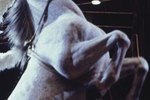Things You'll Need
12 feet 1/4 inch or 3/8 inch double-braided nylon or polyester rope, strength of 2,000 lb. per square inch
Soft measuring tape
Scissors
Lighter
Making a rope halter for a mini horse will be a bit tricky on the first attempt. However, once you get the hang of it you should be able to put together the halter in less than half an hour. Rope halters are inexpensive and durable, according to the Pony Club Victoria.
A rope halter consists of a series of knots. Each knot hits a particular pressure point on the horse's head. When the horse acts up and tries to pull away, it forces the knots to hit his pressure points. This is uncomfortable, teaching the horse to correct his behavior.
Measure 26 inches from the end of the rope. This is where you will make the first knot, which will sit below the mini's right ear. When you have found this point tie a simple knot, just like you are tying shoelaces. However, do not tighten the knot fully yet, as it is likely that you will want to make some adjustments when you have finished the halter and tried it on your mini.
Measure 6 inches from your first knot and tie another simple knot. This knot is for the right side of the nose.
Measure 7 inches and then tie your next knot. This is for the knot that sits on the left side of your miniature horse's nose. The space between this knot and the right side nose knot is the section of rope that sits over the mini's nose.
Measure 27 inches and tie one more simple knot, creating the throat-latch knot.
Measure 7 inches. This next knot is the tie loop. Hold both sides of the rope together to create a loop. Then wrap the the rope at the 7-inch point over the two sections of rope and then under the itself in an overhand knot. Your loop should be 4 inches long. When the rope halter is complete this loop will sit under the horse's left ear.
Measure 7 inches along the unused section of rope and then tie a double-overhand knot. To tie a double overhand knot snake the rope through the loose end of the existing knot (you may have to loosen it to open up adequate space). Wrap the rope over the knot so it sits into the dent in the knot and put it through again. Tighten just enough to know that you have succeed in making this knot.
Bring the rope to the right nose knot and tie another double-overhand knot there. The two sections of rope sitting between the left and right nose knots should be the same length. Use your measuring tape to ensure that the distance between the throat-latch knot and the left nose knot are equal to the distance between the throat-latch knot and the right nose knot. You should now be able to tell that your ropes and knots look like a halter.
Measure 27 inches from the right nose knot and bring this point to the throat-latch knot. Using the double overhand knot, tie the rope into the throat-latch knot.
Tie a double-overhand knot into the right ear knot. The distance between this knot and the throat-latch knot should be the same as the distance between the throat-latch knot and the tie loop.
Take the two long sections of rope that come out from the throat-latch knot and go up to the noseband knots, holding them together. Create a 4-inch loop at the bottom and tie an overhand knot loosely. This loop should sit under your mini horse's chin where the lead rope is attached.
Cut any frayed strands from the ends of the rope and use the lighter to melt the ends.
Put the rope halter on your mini horse. Make any adjustments needed for a better fit by moving around the relevant knot. When you are happy with the fit, tighten up all of your knots.
Tips
You can buy the rope for your halter at your local hardware store.
Warnings
Learn the correct way to use a rope halter on your horse before trying this type of training. Horses--even miniature ones--can be dangerous, so take the necessary safety precautions when working with them.
References
Writer Bio
Siobhan Russell has been freelance writing for the Internet since 2003. She has written articles covering a variety of subjects for Travelwand, Yellow Pages and eHow. Siobhan has a particular interest in writing travel and equestrian articles. She has a BA Honors in History and Philosophy from National University Ireland, Maynooth.



